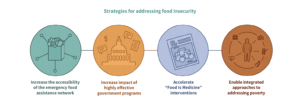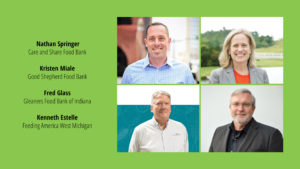Food banks typically consider the pantries in their network to be their “customers,” which keeps them one step removed from the people who actually go to the pantries. Matt Habash, CEO of Mid-Ohio Food Collective, in contrast, has spent more than a decade trying to get his organization closer to the food-insecure people using the pantries. It’s a strategy that has helped him earn our Food Bank CEO of the Year for 2023.
“Our real customer is the hungry person,” Habash said. “What do we know about them? How do we learn more? How do we be responsive to them? That’s been the ten-plus year journey we’ve been on.”
Habash may call himself “an old guy trying to figure out how to use technology,” but he had the foresight years ago to emphasize data collection and analysis. In a bid to be customer-centric, Mid-Ohio Food Collective keeps a staff of five to six full-time employees on a data analytics team that maintains insights into the 700,000 or so unique individuals who go to the food bank’s pantries. “There’s not a business decision we don’t make without that data,” Habash said.
Habash likes to say that he always knew where hunger picked up its food, but with data, now he knows where hunger lives. Customer data showed that hunger often lived far away from where pantries were located, causing people to drive long distances to get the food they needed. “We want people staying closer to home,” Habash noted.
Mid-Ohio uses community and demographic data to round out the information known about each customer. One area it serves has the highest number of Nepali people in need outside of Nepal, for example, while another is at least 75% Hispanic. The landscape of social need is also a consideration. The food bank knows, for example, which communities have the highest eviction rates.
How we did it: Food Bank News put out a call to all of our subscribers for nominations for our Food Bank CEO of the Year, and received more than 100 nominations. Our editors chose our 2023 CEO of the Year after carefully reviewing the full collection of nominees. (While a few CEOs were nominated more than once, the number of times a CEO was nominated was not a factor in the final decision-making.)
All of that data helped build the food bank’s Mid-Ohio Market strategy, which places grocery-store-like markets full of fresh, healthy food in high-need areas. Fortifying the Markets are wraparound social services that are attuned to the local situation. Where eviction rates are high, for example, Mid-Ohio invites in providers of tenant legal aid, community mediation, and rental assistance. The Market at a local community college, meanwhile, is paired with a student success center. With the data it maintains on individuals, Mid-Ohio can determine which of the wraparound services a person might qualify for.
Mid-Ohio now has eight Markets, all of which have longer hours, with some featuring evening or weekend hours or availability up to 41 hours a week. Recently, the food bank took the concept of accessibility even further when it introduced Amazon-style food lockers that let people order food and then pick it up at their convenience, any time of the day or night (Food Bank News wrote about the lockers here).
The Markets and the lockers are all part and parcel of better serving food-insecure people as individuals. “It’s all under the guise of ‘How do we be much more customer-centric?’” Habash said. “How do we make sure we’re meeting the customer where they’re at?’”
Early in his career, Habash worked for a local nonprofit that offered a comprehensive set of social services, but in a way that felt disjointed to the person in need. “That early lesson taught me a lot,” he said, about co-locating services in a way that maximizes impact. He got into food when he was invited into the homes of the youth-group kids and saw the scarcity of their cupboards. “It stuck with me when I saw those kids,” he said.
Looking forward, Habash is positioning the food bank and its network peers to be highly relevant in what he calls the “food as health” (also known as the Food as Medicine) movement. Years ago, Habash led Feeding America’s national effort to distribute more produce, resulting in the creation of six regional produce cooperatives across the country and 1.8 billion pounds of produce distributed by the network last year. So he is well aware that Mid-Ohio and its fellow food banks are qualified to work with the healthcare industry to provide healthy food to food-insecure patients.
Habash is working with other food bankers to develop a model that would get food banks and healthcare providers working together in a big way. While a number of food banks, including Mid-Ohio, have run small, successful, grant-funded Food as Medicine pilots, “no one has gotten to the point where we’re teaching each other well how to scale it,” Habash said, adding, “This is a unique time for food banks to really reposition themselves in the healthcare space.”
Managed care organizations can save significantly by keeping their populations healthier, and food banks can help them do that by providing healthy food. “We’ve re-positioned ourselves as a low-cost, high-value healthcare strategy,” Habash said. Now the trick is in getting healthcare providers to pay food banks to provide that healthy food. “If healthcare pays for it, we can do it all day long,” he noted. “If healthcare doesn’t help, then philanthropic dollars will not go far enough.”
Habash sees a role for a toolkit or information sharing mechanism so food banks can better respond to Food as Medicine requests from the healthcare industry. Food banks may need help with negotiating strategies, or knowing what questions to ask, or coming up with solutions that the healthcare industry can plug into, he said. Without a concerted effort, then national companies like Amazon, Walmart or Kroger may well step in to become the main healthy-food partners of healthcare providers.
That’s not necessarily a bad thing. “What wins is that we as a society realize that regular access to healthy, nutritious food matters to your health,” Habash said. In the near term, he expects food banks will expand their role in providing fresh and healthy food. “But the long-game strategy for America can’t be that food banks keep getting bigger,” he said. “How do we co-create a community where everyone thrives?” – Chris Costanzo
Like what you’re reading?
Support Food Bank News
This article was made possible by the readers who support Food Bank News, a national, editorially independent, nonprofit media organization. Food Bank News is not funded by any government agencies, nor is it part of a larger association or corporation. Your support helps ensure our continued solutions-oriented coverage of best practices in hunger relief. Thank you!
Connect with Us:










